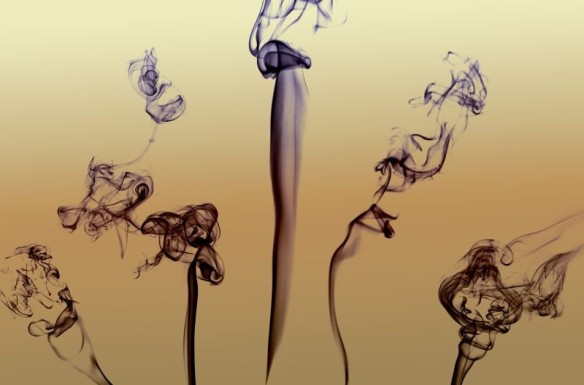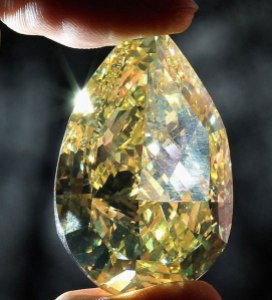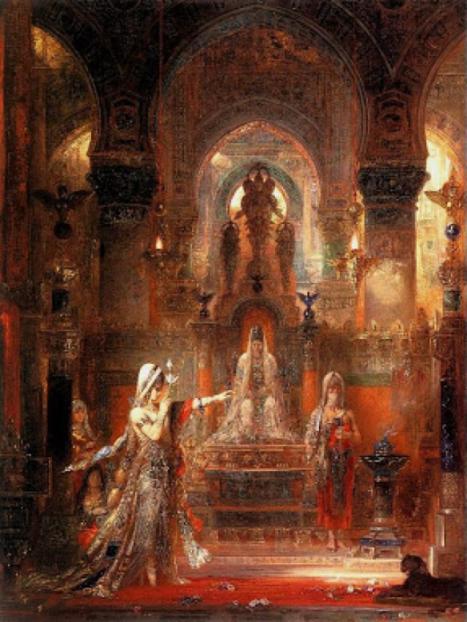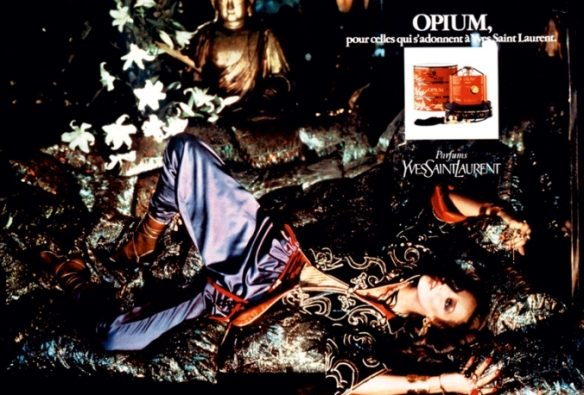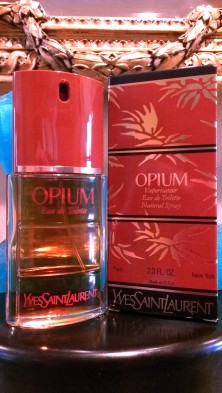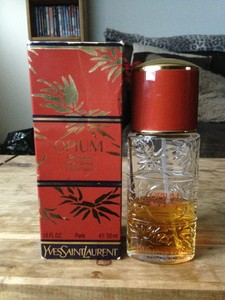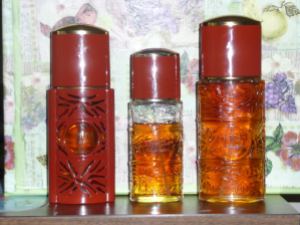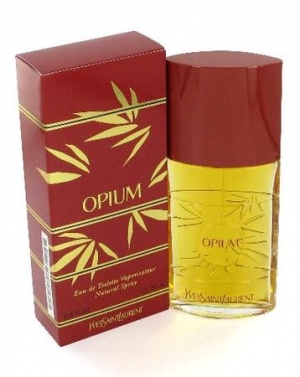The dainty, fragile, green lily transformed into a smoky, spicy, rich flower of the Orient. That is the essence of Shanghai Lily, the latest Private Blend fragrance from Tom Ford. It is part of a brand-new collection of fragrances within his Private Blend line, and was just released in July 2013. The collection is called Atelier d’Orient, and consists of four perfumes: Shanghai Lily, Plum Japonais, Fleur de Chine, and Rive d’Ambre. I’d heard that the first two were the best, so I focused solely on those, starting with Shanghai Lily. (You can find my review for Plum Japonais here, but, to summarize it in a nutshell, Tom Ford tried to copy Serge Lutens and his gorgeous, magnificent Fille en Aiguilles. Tom Ford failed. Badly.)
 None of the new Atelier d’Orient fragrances are listed yet on Tom Ford’s website, but, according to the Moodie Report, Tom Ford’s inspiration for Shanghai Lily was the famed, ancient Silk Road:
None of the new Atelier d’Orient fragrances are listed yet on Tom Ford’s website, but, according to the Moodie Report, Tom Ford’s inspiration for Shanghai Lily was the famed, ancient Silk Road:
This fragrance began with a dream of the Silk and Spice Roads – the ancient, Asian trading routes for luxurious and precious goods[.] I imagined caravans piled high with treasures, and being surrounded by a multi-sensorial abundance of opulence.
Fragrantica classifies Shanghai Lily as an “Oriental Floral,” and says the notes include:
spicy notes, floral notes, olibanum [frankincense], vanilla, bitter orange, pink pepper, black pepper, cloves, jasmine, rose, tuberose, vetiver, cashmere wood, benzoin, castoreum, labdanum, guaiac wood and incense.
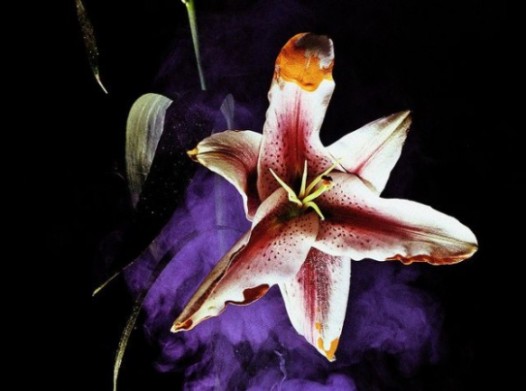
Photo: Henry Hargreaves Photography. “Smoke and Lily” series. Source: Trendland.com http://trendland.com/henry-hargreavess-smoke-and-lily-photography/
Shanghai Lily opens on my skin with the daintiest of lily notes. Fresh, green and airy, it turns within seconds into something sultry and smoky. Sharp incense smoke, a touch of resins, and a cloud of spices transform the white flower into something dark, thick, rich, and heady. There is a subtle orange note lurking alongside which feels, simultaneously, bitter and like the concentrated oil from a freshly grated orange rind. Quickly, a hint of cumin rises out of the dusty spice blend, smelling sweet and strong, and flecked with incense smoke. It’s quite unexpected, but cumin-phobes should not worry. It lasts all of about three minutes.
Shanghai Lily’s base is interesting. In those early minutes, there is a surprising, almost foody aroma of sweet, yeasty bread that pops up out of nowhere. It’s a scent that I’ve now come to associate with certain kinds of beige woods, not only cashmere blends or the ersatz “sandalwood” in some fragrances, but also, sometimes, guaiac wood. The latter often has a very dry, smoky aroma that can sometimes feel like burnt autumnal leaves but, here, in Shanghai Lily, it’s taken on a sweet edge at first. Later, it turns sour and bitter in one of my least favorite aspects of the fragrance. Also lurking in the base is castoreum. It has a plush, velvety feel which adds to the amber and resinous notes that make up the base. The overall combination is a heady, slightly musky, velvety amber mixed in with dry, smoky woods.
The top notes in Shanghai Lily are initially all about the smoke and spices. The fragrance is heavy with a gorgeous burst of ancient, oriental, frankincense mixed with the fiery kick of black pepper and a powerful note of cloves. The way that the trio combines with the bitter orange is vaguely reminiscent of my precious holy grail fragrance, vintage Opium from YSL, but the similarity is fleeting. For one thing, Opium has a powerful start of juicy plum, citruses, and bergamot, and the minor, muted sprinkling of bitter orange in Shanghai Lily cannot compare. For another, vintage Opium was centered on true, Mysore sandalwood, with a heavily resinous feel, real animal musk, and a good amount of castoreum. None of the notes in Shanghai Lily can compare in depth, quantity or intensity, though I’d bet that Opium — that legendary, glorious, benchmark oriental fragrance — was a strong inspiration for Tom Ford. The heavy infusion of cloves mixed with incense is too clear a signal.

Photo: Henry Hargreaves Photography. “Smoke and Lily” series. Source: Trendland.com http://trendland.com/henry-hargreavess-smoke-and-lily-photography/
Shanghai Lily’s opening minutes are not much about the lily, though that soon changes. At first, the lily is hidden and muted behind the heavy veil of that gorgeous clove-incense-spice mix. Less than 10 minutes into the perfume’s development, it starts to emerge in much greater strength. It feels as though a Stargazer lily has suddenly been dunked in a syrup made from dark resins, bottles of cloves, and a hearty, exuberant, uninhibited tossing of frankincense. Flickers of vanilla dance all around the edges, adding to the sweetness of the floral bouquet. The castoreum feels much more distant now than in the opening, as does the dry, woody guaiac, but there is still a subtle muskiness that infused the scent.
Shanghai Lily becomes increasingly floral in nature. The lily is joined by jasmine that is potent, heady, and languorously indolic. There are hints of rose and tuberose that flitter about, and something that resembles the purple, airy, fresh delicacy of violets. The overall bouquet is infused primarily with frankincense smoke and cloves; the orange and cumin are long gone by the twenty-minute mark. Yet, for all the heady, heavy, oriental opulence of the florals, Shanghai Lily has some dryness, too. The smoke and lurking, distant guaiac wood create some balance to the sweetness, ensuring that it’s never pure goo or syrup. Still, the fragrance is extremely potent in strength, and somewhat heavy in feel, at least initially.
At the end of the first hour, Shanghai Lily is primarily a quartet of cloves, lilies, jasmine, and frankincense atop a base of amber and woods, and it remains that way for a number of hours. Although the notes don’t change significantly, the lily and jasmine do fluctuate in strength, as do some of the background florals like the tuberose. I also noticed that the lily becomes much more prominent when the fragrance is worn in the heat and humidity.
The main change in the first few hours, however, is in texture. Around the 90-minute mark, the perfume’s edges blur, and the notes start to overlap. Shanghai Lily still emits its main bouquet of notes, but a lot of the sweetness has faded, as has the strength of the smoke. The dark, syrupy resins underlying the scent seem much fainter, too, though the vanilla still lingers. Shanghai Lily feels much drier and woodier, with slightly more peppered, smoky woods that now have a somewhat sour, bitter edge to them. Still, as a whole, Shanghai Lily is a rich, spicy floriental with a dry, woody smokiness. It’s not as dense in feel, and it hovers just an inch above the skin with substantially reduced sillage as well.
One thing I’ve always noticed about Tom Ford fragrances is that it is better to err on the side of caution when it comes to dosage and application amounts. His Private Blend fragrances, in particular, carry a wallop at first, so spraying your usual amount of perfume can be a deadly thing. Not only is their projection enormous, but the potency of the Private Blends can overwhelm the nose, sometimes making it harder to detect all the subtle nuances. Spraying (as opposed to dabbing) simply compounds the problem, as aerosolization just makes fragrances stronger. With Shanghai Lily, as with many Tom Ford fragrances, I tested it twice, with the second time focused solely on the perfume’s range and sillage in the first 3 hours. The first time, I was recklessly dabbed on a very large amount — about 4 large smears or the equivalent of 2 extremely large sprays– and the sillage was unbelievably potent at first. The perfume also showed a good range of layers and notes. However, during my second test, I applied only about 2 medium-ish smears (the amount you’d get from about 1 moderate spray), and I noticed a difference. Shanghai Lily turned flat, amorphous, and abstract shortly after the first hour. The notes all blurred into each other, and the fragrance lacked significant nuance. It’s something to keep in mind when you test the fragrance for yourself.
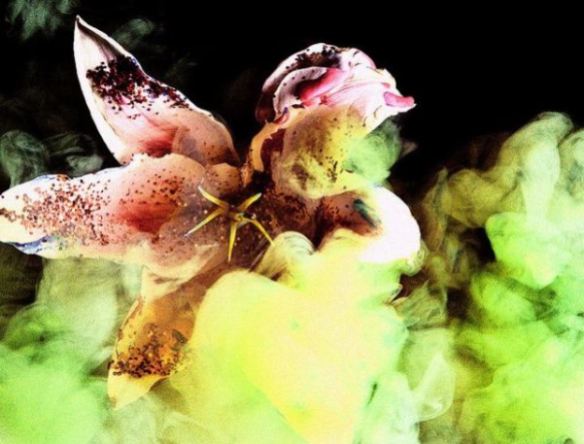
Photo: Henry Hargreaves Photography. “Smoke and Lily” series. Source: Trendland.com http://trendland.com/henry-hargreavess-smoke-and-lily-photography/
Yet, even with the greater dosage, Shanghai Lily becomes a skin scent much faster than that initial power and potency would lead you to believe. Less than 2.25 hours in, Shanghai Lily is just a sheer, unobtrusive, soft veil right on the skin. It’s also almost wholly abstract in nature, a vague puff of white flowers just barely dominated by lily and which have a slightly bitter, spicy, incense nuance. Around the start of the third hour, that odd, sour bitterness in the woody base bothers me even more, but I’m starting to be distracted by something else: the vanilla. The light flecks of vanilla that darted around Shanghai Lily’s edges in the opening are now becoming very noticeable.
At the end of the third hour, the vanilla starts to feel like the only individually distinct, concrete note in the spicy, floral blur, and it’s quite lovely. It’s creamy, frothy, airy, and very smooth. It almost feels rich enough to be called “custardy,” but the note is ultimately too sheer and gauzy for that adjective to truly apply. It’s a very well-balanced element that is far from sweet, thanks to the woody dryness and the black, frankincense smoke underlying it. From this point forwards, for the next three hours, Shanghai Lily is primarily a dry, smoky vanilla scent on my skin. The other notes — from the amber and spices to the florals — are wholly nebulous, amorphous, and tangential blurs in the background. Around 6.25 hours in, even the vanilla turns hazy, and Shanghai Lily is nothing more than smoky sweetness. It remains that way until the end, though the perfume’s smokiness sometimes seems much stronger than it was during the nebulous middle stage.
All in all, Shanghai Lily seems to have three distinct stages. In the first, the fragrance is dominated by a very spicy, smoky floral quartet of notes (lily, jasmine, cloves and incense) atop a plushly ambered base. In the middle stage, the perfume becomes more vague, hazy, and the edges between the notes blur. It also becomes woodier, and drier. There are growing hints of vanilla which helps Shanghai Lily transition into its final stage of being a very airy, frothy, vanillic confection infused with dry smoke. In its final moments, the fragrance is merely a lingering trace of smoky sweetness. Shanghai Lily lasted just over 9.25 hours on my perfume-consuming skin with a large dosage (about 4 large smears), and the projection was extremely soft after the first potent hour. I suspect those numbers would differ dramatically if one sprayed, instead of dabbed, and if one sprayed on a lot.
I like Shanghai Lily, quite a bit, and, yet…. it doesn’t move me. It hits all the right notes on paper: I adore the walloping clove-incense combination; I love lilies and tuberose; and I enjoyed the drydown. But Shanghai Lily didn’t evoke anything emotionally, it didn’t transport me, or conjure up visions in my head. I like it more than a number of existing Tom Ford Private Blends, but something is holding me back. I don’t know what it is, but I suspect the nebulousness and the flatness of the notes after the first 90-minutes have a lot to do with it. Something about Shanghai Lily simply doesn’t seem as interesting as it might have been, given those notes and that powerful spicy, complex beginning. I suppose the fragrance just seems to go a little downhill, a little too quickly, and nothing about the middle phase or even the last one is all that interesting, dramatic, or original. When I smell the opening, I perk up a little, but I suspect I’ll remember Shanghai Lily in the months to come as “that perfume with the really lovely opening that I should have liked more but ultimately didn’t, because it wasn’t interesting.” None of this is helped, of course, by Tom Ford’s prices which have just gone up to $210 for the smallest size. I could tolerate a fragrance that goes from interesting to amorphously flat and abstract, if Shanghai Lily weren’t such a muted creature with a hefty price tag. And, yet, I have to repeat again, it’s actually quite a lovely perfume. It simply isn’t lovely enough, for me, especially for the price.
Bois de Jasmin doesn’t share my ambivalence towards Shanghai Lily. She adores it, though she wishes she didn’t, given Tom Ford’s prices. Her review reads, in part, as follows:
I like my flowers with a twist, and Shanghai Lily is a white floral with a dark mood. The jasmine and tuberose are warmed up and cossetted with plenty of spices and dark resins, which is already interesting. But the best part is that nothing about Shanghai Lily is heavy or oppressive. Instead, it sparkles from its gingery top notes to the incense accented drydown. […]
As much as it pains me to admit it, given Ford’s price tag, Shanghai Lily is beautiful. I love how it sizzles with pepper and clove, which are then toned down by orange. The promised lily is composed out of different floral notes, and its waxy white petals take shape slowly out of rose, violet, and jasmine. And then suddenly, you have on your skin a corsage of Madonna lilies powdered yellow with sweet pollen.
Later, the lilies wilt, leaving you with the scent of an antique rosewood box that not only smells of wood shavings, but also of incense, musk, and something earthy and smoky. The sweetness is mild, the darkness is tempered, and yet without being heady or dramatic, Shanghai Lily clings to the skin for hours. […] (On the other hand, if you want something to announce your presence, this won’t fit the bill).
At the end of her review, Victoria says Shanghai Lily is significantly easier to wear than some other famous florals, like Serge Lutens’ “femme fatale” perfume, Fleurs d’Oranger: “[Shanghai Lily] is mild stuff, but it’s also easier to carry.” Perhaps that’s my problem. My style is not about “wilting” and “mild stuff.” I like hardcore Orientals that bloody well epitomize “heady or dramatic,” and “mild stuff” simply doesn’t cut it for me. I want my damn vintage Opium, not some wanna-be copy that wimps out after an hour and descends into a nebulous blur, while charging me $210 for the dubious pleasure.
For everyone else, however, Shanghai Lily may be the perfect ticket. Those who find Amouage‘s intense, heady, opulent, complex, powerhouse Orientals to be too much will undoubtedly be grateful for the tame, mild version offered by Tom Ford. It’s a very feminine floriental that is unobtrusive and subdued, but with great longevity, and some interesting bits. It’s easy to wear, versatile, approachable, and may even be suited for conservative office-environments if you’re extremely careful with the amount you apply. And I really do think it’s a sexy, seductive scent. In fact, I have no doubt that Shanghai Lily will be a best-seller, especially as Tom Ford doesn’t have anything else quite like it. (If I’m not mistaken, it is his first non-oud Oriental that is primarily floral in nature, and with heady white flowers instead of the usual roses.) So, I definitely encourage those of you who love white flowers and Orientals to give it a sniff, but if you’re used to really dramatic, heady, smoldering scents like those from Amouage, I fear you may be a little ambivalent as well.



